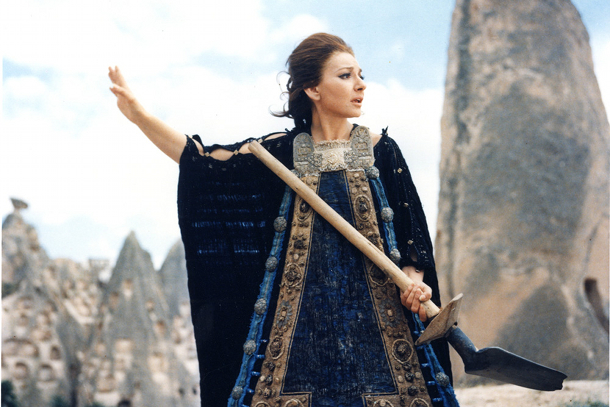
Cast: Maria Callas, Massimo Girotti, Laurent Terzieff
Director: Pier Paolo Pasolini
Country: Italy | France | Germany
Genre: Drama | Fantasy
Official Site: Here
Editor’s Notes: The following review is part of our coverage for TIFF’s Pier Paolo Pasolini: The Poet of Contamination which runs from March 8th to April 12th at TIFF Bell Lightbox. For more information on upcoming TIFF film series visit http://tiff.net and follow TIFF on Twitter at @TIFF_NET.
Pasolini’s screen adaptation of the famous Euripides play, Medea, illustrates profoundly the strange, the mystical, and the unknown. Through an ascetic visual design, sparse editing, and meticulous framing, Pasolini’s Medea sews together the mystical and the realistical, a notion about life that the Centaur (Laurent Terzieff) first presents. Through the relationship which Pasolini presents between rational—almost mathematical—filmmaking and irrational themes, the viewer becomes subject to a bizarre state of nature which perhaps best approximates the mythical setting where Medea takes place.
Through an ascetic visual design, sparse editing, and meticulous framing, Pasolini’s Medea sews together the mystical and the realistical, a notion about life that the Centaur (Laurent Terzieff) first presents.
The story is deftly told through images. Still long takes matched with still close ups of faces subtly express the story. For this reason, the dialogue is quite sparse, and there is little need for establishing separate scenes. At times, this practice becomes quite disorienting, especially when the final sequence is repeated, ever so slightly different, with no significant indication of how to read it. Pasolini’s Medea, consequently, is a film more so to be felt than understood rationally.
 Through death, generational passage, and mythological tropes, Pasolini expresses a lamentation for the ancient world. In an early scene, a man is brutally murdered through ritual sacrifice, and the people, with plates in their hands, are given his blood. In silence, apart from the diegetic Middle Eastern score, they each touch the blood of his heart. The entire sequence is surreal and illustrates the uncanny, almost disturbing, nature of ritual sacrifice. The music at once serves as a requiem for the man’s death as it so too welcomes the spirit of new life granted by God through sacrifice.
Through death, generational passage, and mythological tropes, Pasolini expresses a lamentation for the ancient world. In an early scene, a man is brutally murdered through ritual sacrifice, and the people, with plates in their hands, are given his blood. In silence, apart from the diegetic Middle Eastern score, they each touch the blood of his heart. The entire sequence is surreal and illustrates the uncanny, almost disturbing, nature of ritual sacrifice. The music at once serves as a requiem for the man’s death as it so too welcomes the spirit of new life granted by God through sacrifice.
Pasolini shot the film on location with a desert setting. The scorching sun illuminates the set, sometimes over-exposing the image. This seems to be Pasolini’s intention, however, and not a mistake or example of amateurism even though it might appear as such. Both the setting and the acting recall dramaturgy; there are performative elements that seem to belong to the stage. Unfortunately, some of the acting is difficult to bear, as the performative elements become rather melodramatic on screen. Four times throughout the film, Pasolini superimposes Medea’s face over the actions on screen. The first two times is after her crisis, where she explains that she has become a new person. The second two times is when the climax is shown for the first time, before being repeated anew. This use of superimpositions may serve the plot in presenting Medea’s gaze throughout these events, but it is also quite shoddy and appears a bit unprofessional. This is likely because the film was rendered in 1969, and special effects were not so seamless at the time.
Pasolini shot the film on location with a desert setting. The scorching sun illuminates the set, sometimes over-exposing the image. This seems to be Pasolini’s intention…
Pasolini’s illustration of a new world entering and thus rejecting the ancient world is personified by Medea (Maria Callas). A woman of the ancient world, she experiences confusion for a world that has changed and a personality that is far removed from the woman she once was. She feels like a “vessel bearing experience not [hers]”. For her, reality has changed, and in regards to the film, she is the only one that has changed between the two parallel sequences where time rewinds. Though Jason and their sons (Giuseppe Gentile) are presented through takes that are actually the same, the takes of Medea are different. Since they are shown in separate shots, it’s quite easy to imagine that Pasolini simply edited Medea’s parts, so that she would appear uniquely conscious of the fact that the events are recurring. With a different end to the story and Medea’s control over the fate of the people, it seems that the reliving of an old circumstance or, in another view, the augmentation of an old memory, is the effect of Medea’s sorcery.
Though the film is rather challenging to view, and strikes certain chords that either offend or bore the viewer at times, the rich atmosphere and surreal spectacle which Pasolini presents remains strongly imprinted long after the film ends. For this reason, perhaps Medea is worthy of multiple viewings, with each subsequent viewing contributing more to the reception of its unique and powerful atmosphere than to its technical shortcomings. There is no doubt that a viewer, whether he/she likes it or not, will at least sense something primal and thereby strangely attractive about it.
[notification type="star"]78/100 ~ GOOD. A lamentation of the ancient world, Pasolini’s Medea (1969) illustrates profoundly the strange, the mystical, and the unknown.[/notification]



